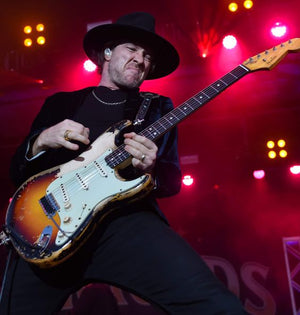
Great songs are not set in stone. Since he burst from the blues clubs of Louisiana onto the global music scene with 1995’s breakthrough first album, Ledbetter Heights, followed by his career defining second album, Trouble Is...in 1997, Kenny Wayne Shepherd has twisted those classic cuts into bold new shapes each night on the stage. Led by the pulse of the crowd, every last note alive in his hands, the Trouble Is...tracks have always been on the move, never settling into museum pieces.But to give a quarter-century-old album a second birth is another matter. And in more recent times, as the five-time-Grammy-nominated, multi-platinum-selling artist looked up the road and saw the 25th anniversary of Trouble Is...on the horizon, he hatched an audacious plan. To join the dots from the hungry 18-year-old gunslinger who caught lightning in a bottle in 1997 to the still-questing master musician, with a lifetime’s soul under his fingers. To assemble the old crew from the original Trouble Is...sessions at the Record Plant in Sausalito, California and attack the track listing afresh. And to remind seasoned fans and new listeners alike how this album struck the match that reignited modern blues. “One of the coolest things about re-recording Trouble Is...has been finding out –or verifying –how timeless this album really is,” says Shepherd, who also is leading a triumphant worldwide anniversary tour in 2022 and 2023, performing the album in full. “I’m so proud of what we accomplished, and also the fact I was just 18 years old when I did it. I mean, I had an experience with this album that most musicians can only dream about. Trouble Is... sold millions of copies. There’s validation in all of that for me.” Even before Trouble Is...put him in the fast lane, Shepherd had ripped through his fledgling career like a street racer. Shown the path by his dad –a renowned Louisiana radio personality and promoter who spun classic blues at home and introduced his son to the legends who made it –Shepherd was soon displaying his own peerless skill with a Fender Stratocaster, fusing a scholarly appreciation of the genre with his own rip-it-up modern attitude. Having pricked up ears with 1995’s sparky debut Ledbetter Heights, Trouble Is...hurled Shepherd headlong into contention. These were songs and performances that shouldn’t have been feasible from a teenager barely out of the classroom, yet the bandleader was already standing shoulder-to-shoulder with a veteran studio band that included the iconic Double Trouble lineup (drummer Chris Layton, bassist Tommy Shannon and keys man Reese Wynans). And while he had yet to find his own singing voice (then, as now, Noah Hunt handles powerhouse lead vocals on Trouble Is...) Shepherd’s precocious guitar work was in a different class to the fading grunge scene, one moment white-hot on originals like Slow Ride or the title instrumental, the next rivalling Jimi Hendrix himself on a wiry cover of I Don’t Live Today. Underpinning the technical dazzle and old-soul touch were the mature songwriting smarts that meant Shepherd was already shaking off the tedious ‘teenage sensation’ tag. Blue On Black –the rootsy fan favorite that hit #1 on the Mainstream Rock chart, set a new record for its 104-week tenure and still blares from stateside radios today –might have been the flagship hit, but there was poignancy and poetry here in spades. “King’s Highway is about a blow-up in a relationship, the guy throwing his belongings into a bag and just walking out the door,” explains Shepherd. “True Lies is the classic infidelity song, a guy suspecting his woman is cheating on him, finding the evidence and confronting her about it. (Long) Gone is that common theme in blues music of moving on.”
Yet Shepherd was always sure to leave room for interpretation. “Blue On Black is obviously about a relationship and the many futile attempts to salvage it,” explains the songwriter.“ But the beauty of that song is that the lyrics just conjure up imagery for the listener to apply to their own experience. Some people tell me it helped them through a breakup, or the loss of a loved one, or they were suffering domestic abuse and that song spoke to them.” In the ensuing 25 years –a period in which Shepherd has released a further seven acclaimed solo albums, not to mention two with his all-star side-project The Rides, alongside Stephen Stills and Barry Goldberg –some aspects of the reborn Trouble Is...album are unavoidably changed. The Record Plant closed its doors in 2008 (the new sessions went down at The Village in Los Angeles and Nashville’s Ocean Way), while Shannon has retired from the music scene (he’s capably replaced by Shepherd’s regular low-ender, Kevin McCormick). “Aside from Tommy, we got the whole crew back together, with Jerry Harrison co-producing once again,” reflects the bandleader. “And in the studio, it felt like no time had passed. If you play well together, you play well together. It worked back then and it worked just as well this time. It was all of us live in a room. That’s just how I do it, man. I’m old-school. Human beings need to be in the same room to be able to play music together.” Other elements of the re-recording were uncannily identical, with Shepherd digging out the exact same ’61 Fender Stratocaster model and backline that he’d used back in the late-’90s. “For amps, I had one of the very first Fender Blackface Twin reissues that was ever made. And then I had a Vibro-King –and that hasn’t really been used again since I recorded that record the first time. So we had those two amps and then a Blackface ’64 Vibroverb. I still had all the original pedals I used back in ’97 –a Uni-Vibe, a TS808 Ibanez Tube Screamer, a Klon overdrive, the Roger Mayer Octavia. I’ve never gotten rid of anything. I’ve never sold anything. So if there’s anything floating around out there that once belonged to me, it’s because somebody must have gotten sticky fingers, y’know?” Ultimately, says Shepherd, the minutiae of his rig was less important than the spirit in the air. “I didn’t want Trouble Is...25 to be a surgical process. I don’t like to overthink things. I just wanted to go in and capture the vibe. There were a couple of ways we could have approached this new recording. We could have done a one-hundred-per-cent faithful reproduction. Or we could have done a complete reinterpretation. “What I chose to do was right in the middle,” he counters. “I wanted to recreate the vibe of each song. Because most people, they’ve been listening to this album for the past 25 years, they’re really familiar with these songs. So at points, you almost feel like you’re listening to the original version –but then, suddenly, there’s a difference that messes with your head.” As he dove into the original Trouble Is...recordings, Shepherd was often pleased to discover that the guitar work of his teenage self was still valid. “Looking back, 18-year-old Kenny Wayne was playing what was appropriate for the song,” he considers. “So much so that the 45-year-old Kenny Wayne didn’t really feel like it needed to be changed. But there were a few guitar solos that I took some liberties on because I was inspired in the moment. There was a little bit of deviation in Somehow, Somewhere, Someway and Nothing To Do With Love. Maybe (Long) Gone, too.I have a lot more control over my instrument now, more intuition and more of an arsenal.” Times change. Artists evolve. Music scenes rise and fall. Back in 1997, the original Trouble Is...was embraced by a rock ‘n’ roll generation crying out for something of substance as vapid manufactured pop began its inexorable rise. “When that album exploded, it was exactly what I had worked so hard for,” he reflects. “And to be honest with you, I had faith. I just felt like there was something bigger steering the ship. I felt like there was something that was meant to happen here, and I just had to facilitate it. I just had to stay true to myself, my instincts,do the best that I could do and kinda watch it unfold.”
A full quarter-century later –with manufactured pop holding sway and humanity clawing its way back from a spirit-sapping global pandemic –the anticipation surrounding the reborn Trouble Is...album and live shows stands as testament to a collection of songs that have never sounded so thrilling, empowering, unflinchingly honest and unapologetically human. “During the Trouble Is...anniversary tour,” says Shepherd, “everybody was commenting on how this album could be released today and still be just as relevant as it was 25 years ago. Making this album in 1997 was just a really monumental achievement. The new recording was a serious trip down memory lane for me. And I’m still so proud of these songs..
Kenny Wayne Shepherd
Great songs are not set in stone. Since he burst from the blues clubs of Louisiana onto the global music scene with 1995’s breakthrough first album, Ledbetter Heights, followed by his career defining second album, Trouble Is...in 1997, Kenny Wayne Shepherd has twisted those classic cuts into bold new shapes each night on the stage. Led by the pulse of the crowd, every last note alive in his hands, the Trouble Is...tracks have always been on the move, never settling into museum pieces.But to give a quarter-century-old album a second birth is another matter. And in more recent times, as the five-time-Grammy-nominated, multi-platinum-selling artist looked up the road and saw the 25th anniversary of Trouble Is...on the horizon, he hatched an audacious plan. To join the dots from the hungry 18-year-old gunslinger who caught lightning in a bottle in 1997 to the still-questing master musician, with a lifetime’s soul under his fingers. To assemble the old crew from the original Trouble Is...sessions at the Record Plant in Sausalito, California and attack the track listing afresh. And to remind seasoned fans and new listeners alike how this album struck the match that reignited modern blues. “One of the coolest things about re-recording Trouble Is...has been finding out –or verifying –how timeless this album really is,” says Shepherd, who also is leading a triumphant worldwide anniversary tour in 2022 and 2023, performing the album in full. “I’m so proud of what we accomplished, and also the fact I was just 18 years old when I did it. I mean, I had an experience with this album that most musicians can only dream about. Trouble Is... sold millions of copies. There’s validation in all of that for me.” Even before Trouble Is...put him in the fast lane, Shepherd had ripped through his fledgling career like a street racer. Shown the path by his dad –a renowned Louisiana radio personality and promoter who spun classic blues at home and introduced his son to the legends who made it –Shepherd was soon displaying his own peerless skill with a Fender Stratocaster, fusing a scholarly appreciation of the genre with his own rip-it-up modern attitude. Having pricked up ears with 1995’s sparky debut Ledbetter Heights, Trouble Is...hurled Shepherd headlong into contention. These were songs and performances that shouldn’t have been feasible from a teenager barely out of the classroom, yet the bandleader was already standing shoulder-to-shoulder with a veteran studio band that included the iconic Double Trouble lineup (drummer Chris Layton, bassist Tommy Shannon and keys man Reese Wynans). And while he had yet to find his own singing voice (then, as now, Noah Hunt handles powerhouse lead vocals on Trouble Is...) Shepherd’s precocious guitar work was in a different class to the fading grunge scene, one moment white-hot on originals like Slow Ride or the title instrumental, the next rivalling Jimi Hendrix himself on a wiry cover of I Don’t Live Today. Underpinning the technical dazzle and old-soul touch were the mature songwriting smarts that meant Shepherd was already shaking off the tedious ‘teenage sensation’ tag. Blue On Black –the rootsy fan favorite that hit #1 on the Mainstream Rock chart, set a new record for its 104-week tenure and still blares from stateside radios today –might have been the flagship hit, but there was poignancy and poetry here in spades. “King’s Highway is about a blow-up in a relationship, the guy throwing his belongings into a bag and just walking out the door,” explains Shepherd. “True Lies is the classic infidelity song, a guy suspecting his woman is cheating on him, finding the evidence and confronting her about it. (Long) Gone is that common theme in blues music of moving on.”
Yet Shepherd was always sure to leave room for interpretation. “Blue On Black is obviously about a relationship and the many futile attempts to salvage it,” explains the songwriter.“ But the beauty of that song is that the lyrics just conjure up imagery for the listener to apply to their own experience. Some people tell me it helped them through a breakup, or the loss of a loved one, or they were suffering domestic abuse and that song spoke to them.” In the ensuing 25 years –a period in which Shepherd has released a further seven acclaimed solo albums, not to mention two with his all-star side-project The Rides, alongside Stephen Stills and Barry Goldberg –some aspects of the reborn Trouble Is...album are unavoidably changed. The Record Plant closed its doors in 2008 (the new sessions went down at The Village in Los Angeles and Nashville’s Ocean Way), while Shannon has retired from the music scene (he’s capably replaced by Shepherd’s regular low-ender, Kevin McCormick). “Aside from Tommy, we got the whole crew back together, with Jerry Harrison co-producing once again,” reflects the bandleader. “And in the studio, it felt like no time had passed. If you play well together, you play well together. It worked back then and it worked just as well this time. It was all of us live in a room. That’s just how I do it, man. I’m old-school. Human beings need to be in the same room to be able to play music together.” Other elements of the re-recording were uncannily identical, with Shepherd digging out the exact same ’61 Fender Stratocaster model and backline that he’d used back in the late-’90s. “For amps, I had one of the very first Fender Blackface Twin reissues that was ever made. And then I had a Vibro-King –and that hasn’t really been used again since I recorded that record the first time. So we had those two amps and then a Blackface ’64 Vibroverb. I still had all the original pedals I used back in ’97 –a Uni-Vibe, a TS808 Ibanez Tube Screamer, a Klon overdrive, the Roger Mayer Octavia. I’ve never gotten rid of anything. I’ve never sold anything. So if there’s anything floating around out there that once belonged to me, it’s because somebody must have gotten sticky fingers, y’know?” Ultimately, says Shepherd, the minutiae of his rig was less important than the spirit in the air. “I didn’t want Trouble Is...25 to be a surgical process. I don’t like to overthink things. I just wanted to go in and capture the vibe. There were a couple of ways we could have approached this new recording. We could have done a one-hundred-per-cent faithful reproduction. Or we could have done a complete reinterpretation. “What I chose to do was right in the middle,” he counters. “I wanted to recreate the vibe of each song. Because most people, they’ve been listening to this album for the past 25 years, they’re really familiar with these songs. So at points, you almost feel like you’re listening to the original version –but then, suddenly, there’s a difference that messes with your head.” As he dove into the original Trouble Is...recordings, Shepherd was often pleased to discover that the guitar work of his teenage self was still valid. “Looking back, 18-year-old Kenny Wayne was playing what was appropriate for the song,” he considers. “So much so that the 45-year-old Kenny Wayne didn’t really feel like it needed to be changed. But there were a few guitar solos that I took some liberties on because I was inspired in the moment. There was a little bit of deviation in Somehow, Somewhere, Someway and Nothing To Do With Love. Maybe (Long) Gone, too.I have a lot more control over my instrument now, more intuition and more of an arsenal.” Times change. Artists evolve. Music scenes rise and fall. Back in 1997, the original Trouble Is...was embraced by a rock ‘n’ roll generation crying out for something of substance as vapid manufactured pop began its inexorable rise. “When that album exploded, it was exactly what I had worked so hard for,” he reflects. “And to be honest with you, I had faith. I just felt like there was something bigger steering the ship. I felt like there was something that was meant to happen here, and I just had to facilitate it. I just had to stay true to myself, my instincts,do the best that I could do and kinda watch it unfold.”
A full quarter-century later –with manufactured pop holding sway and humanity clawing its way back from a spirit-sapping global pandemic –the anticipation surrounding the reborn Trouble Is...album and live shows stands as testament to a collection of songs that have never sounded so thrilling, empowering, unflinchingly honest and unapologetically human. “During the Trouble Is...anniversary tour,” says Shepherd, “everybody was commenting on how this album could be released today and still be just as relevant as it was 25 years ago. Making this album in 1997 was just a really monumental achievement. The new recording was a serious trip down memory lane for me. And I’m still so proud of these songs..







